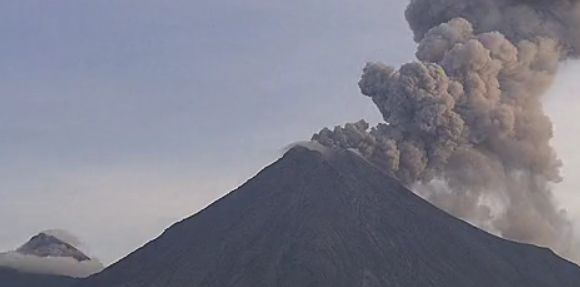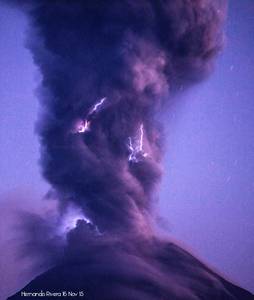Colima volcano showing signs of increased activity, Mexico

The Colima volcano in Mexico exhibited signs of increased activity over the last two days. The volcano, also known as the Fire Volcano, erupted on November 16, 2015, followed by another eruption on the morning of November 17 (local time). Colima has been constantly active since the beginning of July, prompting evacuations on several occasions.
First eruption send a plume of smoke and ash about 3 km (almost 2 miles) into the air, Reuters reported. On November 17, at 07:46 (local time), a flash column spewed by the volcano reached 1.5 km (almost 1 mile) with moderately high ash content, Luis Felipe Puente, the National Coordinator of Civil protection said.

Colima volcano with lightning in eruption column, November 15, 2015. Image credit: Hernando Rivera
Colima has already caused evacuations on several occasions.
Based on satellite images, wind data and reports issued by the Colima Towers and the Mexico City MWO, in the period between November 4 to 7 and on November 9, ash plumes from Colima rose to altitudes ranging between 4.9 and 6 km (3 and 3.7 miles). The ashes spread about 13 to 24 km (8 to 15 miles) north, northwest, west, southwest and south. During November 10, emissions from the volcano were observed every 2 hours, rising up to 5.7 km (3.5 miles) and traveling southwest and west-southwestward.
Video credit: webcamsdemexico.com
Geological summary
The Colima volcanic complex is the most prominent volcanic center of the western Mexican Volcanic Belt. It consists of two southward-younging volcanoes, Nevado de Colima (the 4320 m high point of the complex) on the north and the 3850-m-high historically active Volcán de Colima at the south. A group of cinder cones of late-Pleistocene age is located on the floor of the Colima graben west and east of the Colima complex. Volcán de Colima (also known as Volcán Fuego) is a youthful stratovolcano constructed within a 5-km-wide caldera, breached to the south, that has been the source of large debris avalanches.
Major slope failures have occurred repeatedly from both the Nevado and Colima cones, and have produced a thick apron of debris-avalanche deposits on three sides of the complex. Frequent historical eruptions date back to the 16th century. Occasional major explosive eruptions (most recently in 1913) have destroyed the summit and left a deep, steep-sided crater that was slowly refilled and then overtopped by lava dome growth. (GVP)
Featured image: Colima volcano eruptions on November 17, 2015. Image credit: webcamsdemexico.com

Commenting rules and guidelines
We value the thoughts and opinions of our readers and welcome healthy discussions on our website. In order to maintain a respectful and positive community, we ask that all commenters follow these rules.